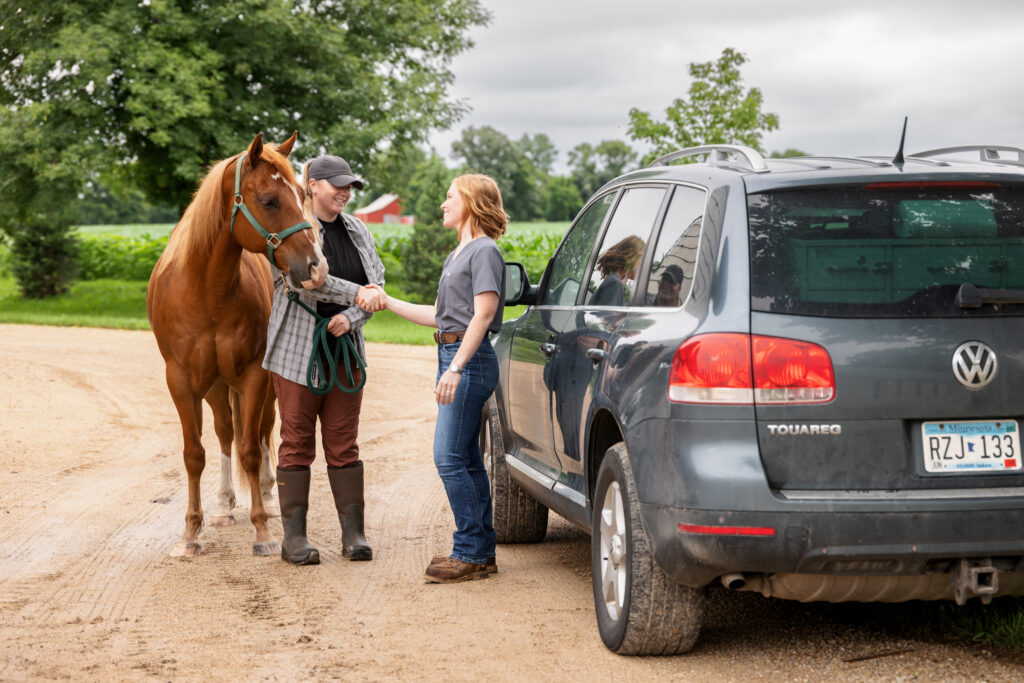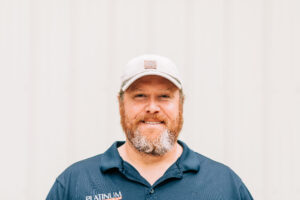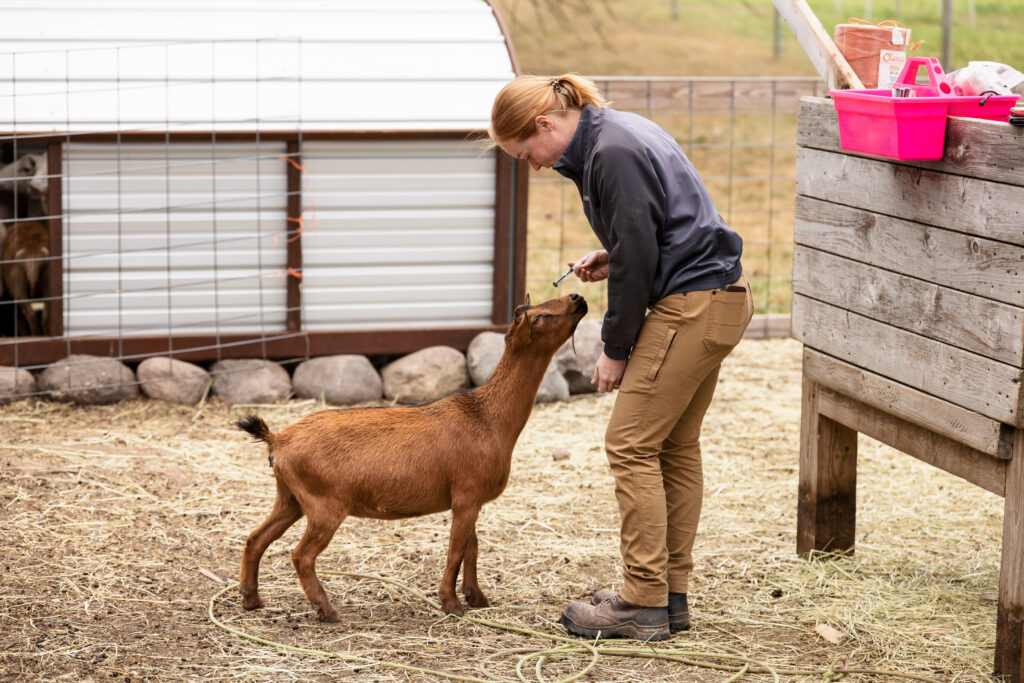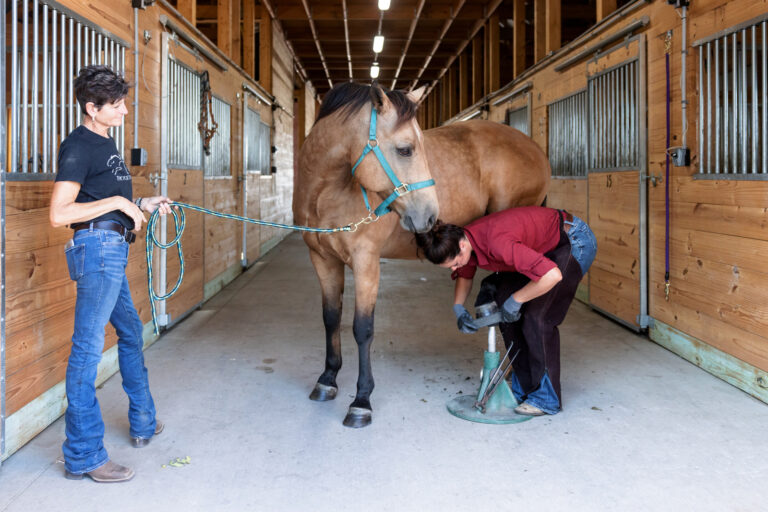This article originally appeared in the Fall 2025 issue of EquiManagement. Sign up here for a FREE subscription to EquiManagement’s quarterly digital or print magazine and any special issues.

In 2024, equine practitioners represented 3,979 of the 86,251 U.S. veterinarians in private practice, according to AVMA demographic figures. An additional 5,282 practitioners identified as mixed animal. The 2025 AVMA Report on the Economic State of the Veterinary Profession revealed that 29% of U.S. veterinarians live in rural areas and 21% work in rural areas.
While most rural practitioners work with a mix of species, the AVMA/AAEP Report on the Economic State of the Equine Veterinary Profession showed that equine practitioners in the U.S. are few and far between in 23 of the 50 states, with each of these mostly rural states having fewer than 60 equine veterinarians. In contrast, the three states with the highest number of horses—Texas, California, and Florida—are each home to between 243 and 438 equine doctors.
Life as a Rural Equine Vet

Rural veterinarians often practice with few colleagues to provide camaraderie and coverage. “I’m a solo road warrior in a rural area. Huge practice area, sometimes two hours one way,” said a veterinarian posting on the Facebook page Equine Vet-2-Vet.
Population density is often low in rural areas, so practitioners must see multiple species, travel long distances, or both to have enough clients and patients to earn a living. In many rural areas, residents’ median income is fairly low, though the cost of living is typically lower, as well. This creates a different kind of practice life.
Kelsey DeLand, DVM, owner and solo mixed practitioner at Ida Veterinary Clinic, in Monroe County, Michigan, says she manages to keep up with new advances in multiple species and feel confident in the care she provides thanks to continuing education (CE) opportunities.
“I go to conferences with large and small animal tracks so I can do both at the same time,” she says. “I take advantage of the excellent free/low-cost CE offered by Michigan State University and Ohio State University. I go to every dinner meeting about every new drug I can. It is a priority of mine to do my best to make time for my pharmaceutical reps so I can learn about the new meds they have coming out.”
DeLand estimates she gets upward of 30 hours of CE annually. She’s also a member of veterinary Facebook groups including Equine, Bovine, Small Ruminant, Porcine, Reproductive, Poultry, Practice Owners, Rural, and more.
“There are so many experts in these groups, and if I post a question I can usually have plenty of answers in less than 12 hours,” she says. “There are also so many new ideas that I pick up from these groups.”
Time on the Road

Traveling long distances between farm appointments eats up a lot of time. It’s one of the biggest challenges for Michael Clark, DVM, a solo equine practitioner who owns South Sound Equine Practice, an ambulatory practice operating out of Washington’s Tenino area. He has had to work hard to control the boundaries of his territory.
“My general limit is about a 45-minute radius from my house,” he explains. “Due to the geographical arrangement of my locale, it is a natural boundary. It also works well to prevent me from driving too far into lesser population-dense areas, only to have to then drive back. The smaller areas that are 15-20 minutes off the main path add 30-40 minutes of drive time to that trip. Every time.”
As a result, Clark has learned to turn down clients located beyond his boundaries. “This has prevented two things: 1) driving too far in the first place (and probably not charging enough for it) and 2) having to be concerned when those clients needed emergency service,” he says. “I also attempt to make sure my days end at a reasonable time. This is a boundary that is often flexed, depending on the day, week, or season. But again, it seems to work more than it doesn’t.”
Referral Limitations and Clinical Constraints
In extremely rural areas like British Columbia, Canada, where Renee Lynn, DVM, has a mixed practice, distance from referral options is a stressor. “I am 16 hours from referral, so either we can treat it, or we can’t,” she says. “I can’t offer referral-level treatment when it’s just me. Let’s try, but if it’s too complicated or not responding correctly, euthanasia is a treatment option.”
Having limited referral options is a double-edged sword. It can provide opportunities to become highly skilled through necessity but also can be discouraging when treatments are simply too labor-intensive or require equipment a small practice doesn’t have.
“As much as I want to be everything for everyone, I just can’t,” DeLand laments. “For instance, I love surgery and love cutting foreign bodies. But I don’t have the staff to be able to hospitalize safely, and after sleeping on the clinic couch and waking up every hour to check on patients a few times, I realized that was something I was just going to have to let go.”
She still performs surgery four days a week but only on an outpatient basis. “Clients are often disappointed when I have to refer them and the costs are so much greater,” she adds. “It’s tough for me, because I have the skills and I want to use them, but it’s just not in the animal’s best interest.”
Guilt and competing desires are common among rural practitioners. For Amanda Alderink, DVM, a solo practitioner at Ticonderoga Large Animal Veterinary Care, the closest equine referral is 1.5 hours away, and the closest food animal referral is 4.5 hours away. She shared some of the things that cause her internal struggle.
“Being on-call 24/7; inability to afford or lack of availability for relief services when I go out of town; tremendous guilt that my clients don’t have definite care and I’ve placed a bigger burden on surrounding practices when I am out of town; guilt that I can’t afford all the diagnostic and treatment equipment that I’d like to offer or hire an assistant; guilt that vet care is so expensive for my clients; resentment that I can’t seem to charge enough to afford relief/equipment/vacations/etc.; guilt every time I miss my kid’s event, am late to pick up, or can’t make dinner due to an emergency; guilt that I lack skills I genuinely thought I’d have after 25 years of vet work.”
The genuine desire to help animals often collides with the need for rest and respite, which requires each veterinarian to prioritize self-care.
Creating Boundaries & Balance

In rural areas, no one might be available to step in if a solo veterinarian leaves town or gets injured. Finding relief coverage is tough. When asked how he makes time for family, vacations, and simply having a life, Clark said he focuses more on making time for his family and less on worrying that he might not be available to clients.
“I found I was spending too much time worrying the phone might ring, and I was missing out on living life,” he says. “Many years ago, I made a conscious decision to make time for those weekends and longer vacations as my daughter grew up.”
To make it work, Clark says he tries to be available to clients during the first half of the year and the busy spring season. But after July 1, he spends more time away, with at least one long summer vacation.
“There are a few other practitioners in the area that clients are able to call and usually can have someone out if needed, and I make sure my clients are aware that while I make an attempt to be available much of the time, there may be times I am unavailable, and my voicemail message will reflect that,” he says.
For vacations longer than a week, DeLand contacts solo vets that have practice areas near hers. “We don’t have any kind of written agreement, but we all just kind of cover for each other when needed,” she explains. “I am forever thankful that we all get along and are willing and able to step up to the plate when one of our colleagues needs us. The tricky thing for me is one of them only does horses and the other will not touch a horse but will do everything else large animal. So it’s basically like finding two ‘relief vets’ to cover my clients when I do go out of town.”
DeLand says the freedom of running her own practice, picking and choosing her clients, and keeping her practice area within reason (40 minutes is her drive radius) makes the on-call worth it. “And, in all fairness, since my dad did this before me and his dad before him, I know what I signed up for,” she adds.
Creating strong boundaries is a necessity in rural practice, where there’s often more need than one person can possibly meet. When animal owners feel entitled to care but complain about its cost or availability, veterinarians can become despondent and burned out.
One rural veterinarian said their biggest challenge is maintaining boundaries to keep their client base manageable for on call. It is unrealistic for them to cover nonclient emergencies because of the vast distance and number of calls.
“I receive multiple calls each day from nonclients seeking care,” the practitioner shared. “I appreciate the ones who graciously respond with, ‘Thank you for the work you do,’ and prepare to haul. The ones who sap me mentally are the ones who try to guilt me into coming. These are also the people who haven’t had a vet out in a decade, if ever. We discuss the need to have an annual relationship with a primary care vet to ensure emergency coverage.”
Having colleagues who share the same struggles helps veterinarians feel less alone. Forming connections with practitioners near and far can help combat feelings of isolation. “Thanks to these Facebook vet pages, I don’t feel lonely and have good relationships with at least three of the nearby practices,” said one rural mixed practitioner. Other veterinarians cherish seeing colleagues at meetings or having regular telephone chats.
Appreciative clients are one of the rewards for rural veterinarians’ long hours and lost family time. In fact, DeLand says her favorite thing about her rural practice is the people. “I love the small community feel we’ve created, and I know that my clients trust me, and I trust them,” she says. “That was not always the case, but I was an aggressive fire-er early on in my career, and my life is so much better because of it.”
These days, DeLand’s clients often apologize for calling her out on an emergency—they understand she has a life, and they appreciate her time and knowledge.
“I honestly keep ‘waiting’ for the burnout to come, especially with my schedule, but I still look forward to work every day, and that’s truly a blessing I do not take for granted.”
Like DeLand, Clark truly enjoys his clients. While it has taken an immense amount of concerted effort, he says fostering client relationships with those he enjoys seeing and working with is much more valuable and financially rewarding than seeing everyone who calls and then trying to make them happy.
Finding Joy in Rural Practice
Despite the challenges, most rural practitioners love their work. One mixed large-animal veterinarian listed the things she loves about her life: “I can make my own boundaries, I get to travel through some gorgeous remote country, the clients I have are wonderful for the most part, 80% of the time I love what I do, I enjoy working with the 4-H and livestock association, and love teaching ride-along students. I truly love my job, and I am happy.”
Melanie Denton, DVM, a mixed animal practitioner from Oklahoma, says, “It’s never the same day twice in a row, and I like the variety. I’m still doing it after 23 years (and yes, my back’s a little sore and so is my right shoulder), but there are still good clients and great outcomes.”
Rural practice can be an amazingly fulfilling, joyful career. The small-town community, slower pace of life, and long-term relationships with clients can create contentment. Despite the pain points, life in the countryside is where many people find their peace. As Sheri Cronin, DVM, of Willits, California, laments, “The toughest part for me is nearing the end of my Road Warrior career. It’s my heart and soul.”
Related Reading
- The Top Factors Influencing Equine Veterinarians’ Job Satisfaction
- Business Briefs: Is a Veterinary Industry Position Right for You?
- The Business of Practice: Relief Veterinarians
Stay in the know! Sign up for EquiManagement’s FREE weekly newsletters to get the latest equine research, disease alerts, and vet practice updates delivered straight to your inbox.




